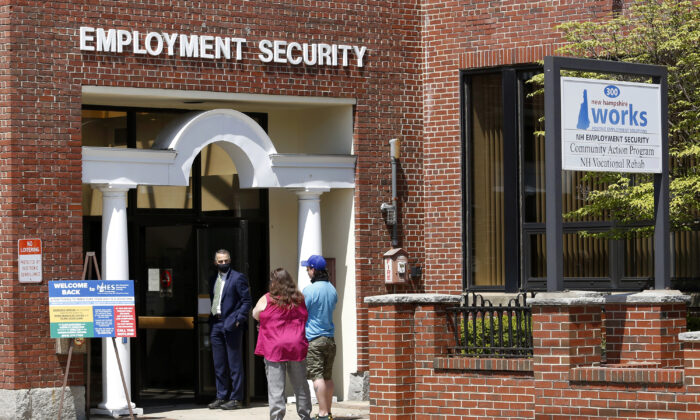
The number of Americans filing jobless claims dropped again last week, as employers continue to seek new workers.
This latest reading may serve as a further data point for the Federal Reserve to pursue its aggressive rate-hike policy, which will likely have a negative effect on hiring.
Initial claims, which have declined since August after rising earlier in the summer, were 213,000, a decrease of 5,000 from the previous week, reported the Department of Labor on Sept. 15.
Economists had predicted the reading would climb to 227,000.
“Initial jobless claims in at 213,000 vs. 226,000 estimated. Sizeable beat on jobs. This adds yet another greenlight to aggressive rate hike action,” wrote Peter Tarr, a private fund manager, in a tweet.
“We would need something very substantial to sway coming rate changes. That is unlikely,” added Tarr.
Strong Job Numbers on Fed Policy
The Fed’s current strategy is to lower inflation to a 2 percent target rate at the expense of the job market.
Policymakers believe that the positive job numbers and low unemployment show that the economy could afford to take a hit with a slight increase in unemployment.
Fed Chairman Jerome Powell said that the central bank must keep interest rates high “for some time” in order to slow the economy down and reduce the worst inflation rates in 40 years.
Powell has admitted that the rate hike will cause “pain” to U.S. households and businesses, but that things would be worse if he allowed inflation to remain at current levels.
He said that the labor market is in a state of imbalance with the number of vacant positions still at twice the amount of available job seekers.
The central bank had already raised its short-term interest rate four times this year, to 2.25—2.50 percent.
Most economists are expecting the Fed to raise its benchmark borrowing rate by 75 basis points (bps) at its next policy meeting next week, as it did in July.
“Jobless claims lower than expected and core CPI with bad (high) print. Fed goes at least 75bps. PPI and Core PPI may have been ‘good enough’ to avoid 100bps, but we will get a very hawkish Powell and higher rates,” wrote Ophir Gottlieb, CEO of Capital Market Laboratories, in a tweet.
The Consumer Price Index (CPI) released on Sept. 13 saw inflation rise again to an 8.3 percent annual rate.
Although it was lower than the 8.5 percent in July, it was higher than the 8 percent predicted by many economists.
The CPI’s food index also rose 11.4 percent, the largest year-over-year increase since May 1979.
However, some analysts have suggested the central bank should raise rates even higher, by 100 basis points.
“While the Fed did not raise rates by 100 bps at the July meeting, contrary to our expectations, we believe recent data will encourage policymakers to revisit whether they should increase the pace of rate hikes, considering the Fed’s commitment to data dependence,” wrote the the North America Economics team at Nomura on Sept. 13.
A Tight Labor Market
Meanwhile, continuing claims, which list individuals who were unemployed for more than a week, increased slightly, to 1.4 million in the week ended Sept. 3.
August saw a solid gain of 315,000 new jobs, but it was lower than the earlier average rate of monthly job growth in the first half of 2022.
The data prove that the job market is still on a strong footing, but has begun to cool off since the beginning of the year.
The unemployment rate in August jumped, to 3.7 percent, up from 3.5 percent in July, which reached its lowest record in a half-century.
Job searchers seeking better employment or were unemployed rose to 62.4 percent last month from 62.1 percent in July.
Separate surveys by the National Federation of Independent Business and the Institute for Supply Management have shown that employers are still struggling fill vacancies.
“These timely data continue to signal that demand for labor is still strong, with layoffs declining, even as the Fed is tightening aggressively,” wrote Rubeela Farooqi, chief U.S economist for High Frequency Economics, in a note.
“For now, businesses still appear to be reluctant to let go of workers at a time when labor shortages are persisting.”
Company earnings are now being affected not just by high inflation and interest rates but also by supply and energy disruptions caused by the war in Ukraine and lockdowns in China.
Despite that, many large companies have said that they intend to slow or freeze hiring in the coming months, rather than terminate existing workers due to the labor shortages.
However, a sharp rise in rates could trigger layoffs in the future, as businesses and consumers pull back on spending.